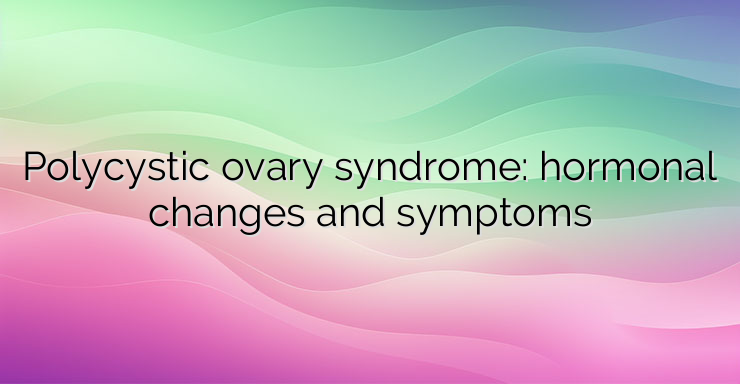Globally, polycystic ovary syndrome affects between 8% and 20% of women of reproductive age. The pathophysiology of this condition is characterized by alterations in steroidogenesis, ovarian folliculogenesis, neuroendocrine function, metabolism, insulin production, insulin sensitivity, adipocyte activity, inflammatory factors, and sympathetic nervous system functions. According to studies, high carbohydrate consumption, hyperinsulinemia, hyperandrogenemia, and persistent low-grade inflammation are the four main factors that contribute to the pathophysiological changes in PCOS. The biochemical hallmark of the condition is hyperandrogenemia – high serum concentrations of male sex hormones, which manifests clinically as hirsutism – increased male pattern hair growth, acne and alopecia – hair loss. High levels of androgens – male sex hormones are observed in 75-90% of patients with polycystic ovary syndrome with oligomenorrhea – a disorder in the regularity of the menstrual cycle, and their concentrations often increase with the severity of the condition. Excessive synthesis of androgens by the ovaries, as well as by the adrenal glands, contributes to the development of hyperandrogenism. Elevated levels of the free – unbound fraction of testosterone are indicative of the condition. Abnormal function of the ovaries or adrenal glands leads to an overproduction of androgens. In polycystic ovary syndrome, impaired folliculogenesis is the initial result of increased androgen production that leads to disruption of normal androgen synthesis. In the early gonadotropin stage, androgen excess promotes the growth of primordial follicles and the growth of antral follicles in the ovaries. The release of gonadotropin hormones from the pituitary gland is triggered by the production of gonadotropin-releasing hormone from the hypothalamus. In order to increase the synthesis of androgens in the theca cells of the ovaries, the luteinizing hormone – LH activates the LH receptor. At the same time, follicle-stimulating hormone – FSH activates the FSH receptor in the ovarian granulosa cells to convert androgens into estrogens, which stimulate follicle growth. Dysregulation of the neuroendocrine system is thought to cause an imbalance in the hypothalamic-pituitary-ovarian axis, which then leads to gonadotropin excess. Elevation of serum concentrations of gonadotropin-releasing hormone favors the production of LH over FSH, leading to a significant increase in the LH:FSH ratio in polycystic ovary syndrome. Theca cells in the ovaries undergo hyperplasia as a result of increased LH stimulation, which also causes follicular fluid to accumulate. This leads to the formation of cystic structures on the periphery of the ovary. Due to the growth of follicles and the expression of basic enzymes involved in the synthesis of androgens,excessive amounts of male sex hormones are produced. Altered metabolism of the stress hormone cortisol is another mechanism thought to account for increased androgen production in patients with PCOS. Increased inactivation of cortisol by 5alpha-reductase or impaired reactivation of cortisol by cortisone by 11 beta-hydroxysteroid dehydrogenase type 1 leads to maintenance of normal plasma cortisol concentrations at the expense of excess androgens. Insulin is the main hormone responsible for both lipogenesis – the formation of adipose tissue – and the regulation of blood sugar levels. Insulin serves as a mitogenic hormone – it stimulates the processes of cell division in addition to its influence on the metabolism of carbohydrates, fats and proteins. Insulin receptors, which are present in many tissues making up the hypothalamic-pituitary-adrenal axis, mediate the actions of insulin. It potentiates the action of relevant trophic hormones in steroidogenic tissues such as the ovary and adrenal cortex to promote steroid hormone production. Because insulin directly mimics the action of LH and indirectly increases gonadotropin-releasing hormone levels, hyperinsulinemia is the primary cause of excess androgen production. Sex hormone binding globulin – SHBG is a key circulating protein that regulates testosterone levels. Its concentrations are lowered by insulin. Therefore, lower levels of SHBG would lead to higher levels of free androgens, which cause the clinical symptoms characteristic of PCOS, such as hirsutism, alopecia, and acne. References: https://www.ncbi.nlm.nih.gov/pmc/articles/PMC9964744/Because insulin directly mimics the action of LH and indirectly increases gonadotropin-releasing hormone levels, hyperinsulinemia is the primary cause of androgen excess. Sex hormone binding globulin – SHBG is a key circulating protein that regulates testosterone levels. Its concentrations are lowered by insulin. Therefore, lower levels of SHBG would lead to higher levels of free androgens, which cause the clinical symptoms characteristic of PCOS, such as hirsutism, alopecia, and acne. References: https://www.ncbi.nlm.nih.gov/pmc/articles/PMC9964744/Because insulin directly mimics the action of LH and indirectly increases gonadotropin-releasing hormone levels, hyperinsulinemia is the primary cause of excess androgen production. Sex hormone binding globulin – SHBG is a key circulating protein that regulates testosterone levels. Its concentrations are lowered by insulin. Therefore, lower levels of SHBG would lead to higher levels of free androgens, which cause the clinical symptoms characteristic of PCOS, such as hirsutism, alopecia, and acne. References: https://www.ncbi.nlm.nih.gov/pmc/articles/PMC9964744/


Leave a Reply